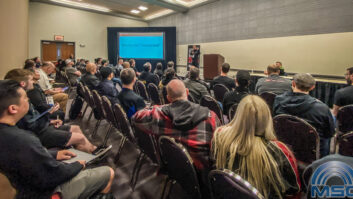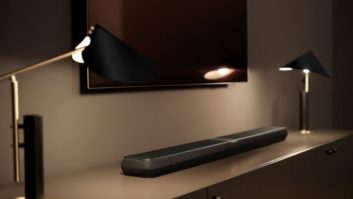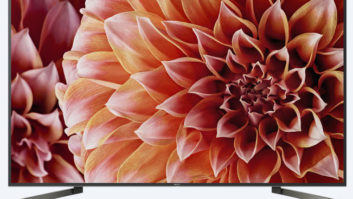TWICE: How important is 3D going to be in the camera
business?
Ron Gazzola, Fujifilm:
We
see 3D as really the next evolution in imaging.
It is a key platform going forward in the industry and definitely for
our company. The Real 3D W1 that we
launched last year was on a small scale, but we were able to really get a lot
of research out of that launch, understand that market and now with the growth
both in Hollywood in 3D, and from the television manufacturers, we think it’s
become a huge platform. Consumer awareness of 3D is rising quickly, and we see
that as a key platform not only on the image capture side in a digital camera,
but also on the printing side and the imaging side of our business.
Bringing 3D into the home is going to happen. The penetration is going to be there, and we
think we’ll be at the forefront of that.
Mark Weir, Sony:
Sony’s
approach to image capture is using a single lens and a single sensor, which
means we can make the camera significantly smaller and lighter, and actually
quite pocketable. We stress the use of
the industry standard MPO format so that devices can easily read the files and
display them. You can directly connect the camera to a 3D television and you’re
good to go. But we also see the
emergence of other platforms. As Ron
mentioned, the potential for printing in 3D has actually already been realized
with 3D displays on PCs for instance. We
think the mainstream approach and value will be 3D in the living room on a
television. The ease of use and really striking nature of 3D photography that’s
available now is going to become a driver no doubt. It’s a new way to enjoy photography.
Chuck Westfall, Canon:
The important thing for us is getting our
R&D to the point where we’re really comfortable with everything that there
is about 3D. One of the things that we’re doing very actively in that area is
through our broadcast optics. The lenses
that we make were used to cover the World Cup in 3D. Also, we’ve got world
baseball, Major League Baseball and other types of sporting events around the
world where we’re collaborating with broadcasters. I think that there is going
to be lot of good that is going to kind
of trickle down to the consumer over a period of time. Canon is going to be there when the time is
right.
Mark Sherengo, Pentax:
We’re also investing in R&D and
looking to see if the penetration of the TV actually gets into the
household. Right now the buzz is there.
Ron Gazzola,
Fujifilm:
I think Mark and Chuck
make a great point. I think the quality
of 3D is very, very critical. The W1 has
a dual-lens dual-processor system to capture high-quality 3D, and as consumers
begin to adopt 3D, their initial few experiences with the product will really
determine whether they get deeper into it.
Mark Weir, Sony:
I would echo Ron’s point. Ensuring the
quality experience of 3D is an essential element of its adoption. If it’s seen as artificial or overdone it
will inhibit the adoption in ways that no one wants to see, and the fact that
we touch every step of the production of 3D and the playback of 3D gives us an
opportunity to deliver the kind of quality that customers are going to need.
David Lee, Nikon:
Nikon makes the machinery in our
steppers that helps the TV manufacturers make flat-panel displays, so we
certainly understand the technology. I think it will be interesting to watch
how 3D evolves over the long term because 3D is not a new concept, and many
companies have come and gone with 3D in photography. So while the devices have been enhanced, it
will be interesting to see if the consumer continues to have a sustained
interest. At Nikon we are focused on what the consumer’s desires are, and we
will continue to follow that. If the demand is there, we certainly will go
after it, but from a display standpoint we don’t really see it as a
disadvantage.
Ron Gazzola, Fujifilm:
A
big aspect for us is to be able to deliver good quality content on all of those
displays that are obviously getting a huge push in the market place both from
manufacturers and retailers. Getting that content onto television in a simple
way is probably the key and I think that’s where we’re pretty focused. The next
step is getting it onto these new 3D displays in a very simple and easy
one-touch manner. That’s where the key is in the back half for us.
Pete Palermo, Kodak:
We’ve got quite a bit of R&D
going on with respect to 3D, but we won’t bring anything to market until
there’s a sizable segment out there to go after. Our customer has this expectation that a
product has to have one-button simplicity both on the capture side as well as
on the enjoyment. So for us, while men
are very forgiving with respect to new technologies and adoption, our core
consumer – the chief memory officer of the household, Mom – has a different set
of expectations and would probably not enjoy the experience available today. If
that experience becomes easier in the future I’m sure our core consumer would
be a target for 3D.
Liz Cutting:
I think there’s also a longer adoption curve
for women. If we look, for instance, at people who own a digital camera and how
are they viewing their devices, it seems that about twice as many male digital camera
users as female are viewing them on TV. So there’s a predisposition to cool,
big screens, and that same trend will probably roll over into 3D a bit. It’s
going to be a longer adoption curve to get down to that one button simplicity,
though. As a female, I accept that the 3D experience is really enriching my
life and my family’s life, I think it’s just a longer curve to get to the
mainstream.
Dennis Eppel, Panasonic:
I think 3D will only expand the
whole imaging category and for 3D it’s really important because it adds
something to the 3D world that is missing, which is content. So we’ll have a
new 3D camcorder out in the fall, which is hitting a very attractive price
point, and with our displays already in the market, we will offer a full
end-to-end solution.










